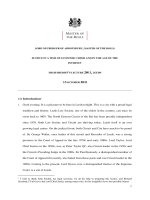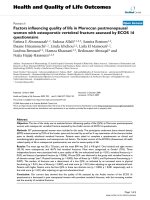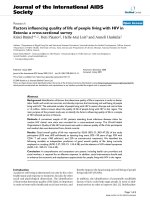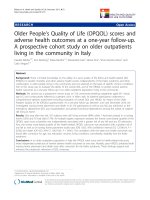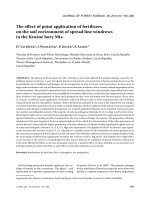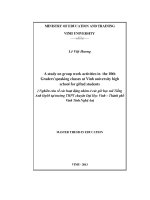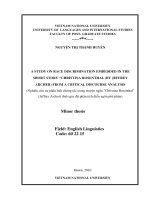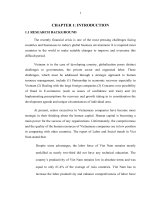Factors influencing quality of working life a study of front line employees in the vietnamese aviation service
Bạn đang xem bản rút gọn của tài liệu. Xem và tải ngay bản đầy đủ của tài liệu tại đây (1.62 MB, 85 trang )
UNIVERSITY OF ECONOMICS HO CHI MINH CITY
International School of Business
________________
Le Thi Hanh An
FACTORS INFLUENCING QUALITY OF
WORKING LIFE: A STUDY OF FRONT-LINE
EMPLOYEES IN THE VIETNAMESE
AVIATION SERVICES
ID: 22130001
MASTER OF BUSINESS (Honors)
SUPERVISOR: DR. NGUYEN THI MAI TRANG
Ho Chi Minh City, Year 2015
ACKNOWLEDGEMENT
Firstly, I would like to express my gratefulness to my supervisor Dr. Nguyen Thi Mai Trang
for her professional guidance, intensive support, valuable suggestions, instructions and
encouragement during the time of doing my research.
I would like to express my deepest gratitude to ISB Professors Committee for their valuable
time as the members of the proposal examination committee. Their comments and
meaningful suggestions were contributed significantly for my completion of this research.
My sincere thanks are given to all of my teachers at International Business School –
University of Economics Ho Chi Minh City for their teaching and guidance during my master
course.
1
Abstract
Purpose – This research aims to explore factors influencing on quality of working life of
front - line staffs in Vietnamese aviation services.
Methodology/Sample – A total of 280 questionnaires were distributed out at many airports in
Vietnam. As the method are directly interviewing combining with online surveying,
respondents including the front-line staffs at those airports such as check in staffs, security
staffs, boarding staffs, hence, data collecting also was primary sources. The hypothesized
relationships were tested using structure modeling.
Findings – This study found that perceived of organization supports, emotion exhaustion,
extra-role services and servicesescape affecting on quality of working life of those
employees. Based on the thesis findings, several implications have been provided.
Key words – Quality of working life, perceived of organizational supports, extra role
services, emotional exhaustion, intrinsic motivation, Vietnamese aviation sector, Vietnamese
airports.
2
Contents
ACKNOWLEDGEMENT .................................................................................................................................... 1
Abstract ................................................................................................................................................................. 2
List of Figures ....................................................................................................................................................... 5
List of Tables ........................................................................................................................................................ 6
List of Abbreviations ............................................................................................................................................ 7
Chapter 1.
Introduction................................................................................................................................... 1
1.1.
Research background ............................................................................................................................ 1
1.2.
Statement of the problem ...................................................................................................................... 3
1.3.
Research objectives............................................................................................................................... 5
1.4.
Research scope ...................................................................................................................................... 6
1.5.
Research significance ........................................................................................................................... 7
1.6.
Structure of the study ............................................................................................................................ 7
Chapter 2.
Literature review ........................................................................................................................... 9
2.1.
Quality of working life (QWL) ............................................................................................................. 9
2.2.
Perceived organizational support (POS) ............................................................................................. 12
2.3.
Emotional exhaustion (EE) ................................................................................................................. 14
2.4.
Extra-role customer service (ECS) ..................................................................................................... 15
2.5.
Servicescape (SE) ............................................................................................................................... 17
2.6.
Intrinsic motivation (IM) .................................................................................................................... 18
2.7.
Model and hypotheses ........................................................................................................................ 22
2.7.1.
Research model ........................................................................................................................... 22
2.7.2.
Hypotheses .................................................................................................................................. 22
Chapter 3.
Research Methodology ............................................................................................................... 24
3.1.
The research design ............................................................................................................................ 24
3.1.1.
Qualitative research .................................................................................................................... 24
3.1.2.
Main survey method ................................................................................................................... 25
3.1.3.
Research procedure ..................................................................................................................... 25
3.2.
Measurement scale building ............................................................................................................... 26
3.3.
The main survey.................................................................................................................................. 27
3.3.1.
Objects of main survey ............................................................................................................... 27
3.3.2.
Sample size ................................................................................................................................. 27
3.3.3.
Research sample description ....................................................................................................... 28
3
Chapter 4.
Data analysis and results ............................................................................................................. 31
4.1.
Reliability analysis.............................................................................................................................. 31
4.2.
Confirmatory factor analysis............................................................................................................... 34
4.2.1.
Perceived organizational supports (POS) ................................................................................... 35
4.2.2.
Intrinsic motivation ..................................................................................................................... 36
4.2.3.
Emotional exhaustion ................................................................................................................. 37
4.2.4.
Extra role customer services ....................................................................................................... 38
4.2.5.
Servicescape................................................................................................................................ 39
4.2.6.
Quality of working life (QWL) ................................................................................................... 40
4.3.
The discriminant validity among the six constructs............................................................................ 41
4.4.
Model evaluation ................................................................................................................................ 42
4.5.
Hypotheses evaluation ........................................................................................................................ 45
4.6.
Research findings ................................................................................................................................ 47
Chapter 5.
5.1.
Conclusion .................................................................................................................................. 49
The main results and research contributions ....................................................................................... 49
5.1.1.
Measurement model .................................................................................................................... 50
5.1.2.
Managerial implications.............................................................................................................. 51
5.2.
Limitations and future research .......................................................................................................... 54
References........................................................................................................................................................... 56
Appendix 1. Source of measurement scales ....................................................................................................... 62
Appendix 2: Guidelines for In-Depth Interview ................................................................................................. 65
Appendix 3. English questionnaire ..................................................................................................................... 71
Appendix 4: Questionnaire (Vietnamese Version) ............................................................................................. 74
4
List of Figures
Figure 2.1 The conceptual model ............................................................................................ 22
Figure 3.1 Research procedure ................................................................................................ 25
Figure 4.1 CFA model of Perceived organizational supports ................................................. 35
Figure 4.2 CFA model of intrinsic motivation ........................................................................ 36
Figure 4.3 CFA model of Emotional exhaustion ..................................................................... 37
Figure 4.4 CFA model of extra-role customer services........................................................... 38
Figure 4.5 CFA model of servicescape ................................................................................... 39
Figure 4.6 CFA model of Quality of working life ................................................................... 40
Figure 4.7 SEM of research model ......................................................................................... 44
5
List of Tables
Table 3.1 Sources of data collection ........................................................................................ 28
Table 3.2 Description of sample .............................................................................................. 29
Table 4.1 Reliable test result ................................................................................................... 32
Table 4.2 Confirmatory factor analysis results of POS ........................................................... 35
Table 4.3 Confirmatory factor analysis results of IM ............................................................. 36
Table 4.4 Confirmatory factor analysis results of EE ............................................................. 37
Table 4.5 Confirmatory factor analysis results of ECS ........................................................... 38
Table 4.6 Confirmatory factor analysis results of SE.............................................................. 39
Table 4.7 Confirmatory factor analysis results of SE.............................................................. 41
Table 4.8 Discriminant validity test result............................................................................... 41
Table 4.9 Results of measurement scale evaluating ................................................................ 42
Table 4.10 Fitness of conceptualized model ........................................................................... 43
Table 4.11 Final results of relationship checking of model’s constructs ................................ 45
Table 5.1 Managerial implication: How can the manager assess quality of working life of
their front-line staffs? .............................................................................................................. 51
Table 5.2 Managerial implication: How can the manager reduce the emotional exhaustion as
well as increase the extra-role customer services of their front-line staffs?............................ 52
6
List of Abbreviations
Abbreviations
Meanings
1.
CFA
Confirmatory factor anlysis
2.
ECS
Extra role services
3.
EE
Emotinal exhaustion
4.
GDP
Gross National Product
5.
IM
Intrinsic motivation
6.
POS
Perceived of organizational supports
7.
QWL
Quality of working life
8.
SE
Servicescape
9.
SEM
Structure equation modeling
10.
VGP
Vietnam Government Newspaper
7
Chapter 1.
Introduction
1.1. Research background
According to the General Statistics Office of Vietnam, the service industries increased
over 6.56% in 2013, which contributed over 50% growth to total GDP in the same year (VGP
News, 2013). Playing the most indispensable role in the group of services – related sections,
aviation has been developed for long time.
Asia is known as one of the most potential leading areas in passenger traffic where the
volume of passengers carried by airlines is rapidly increasing (5% per month in 2013). It is
also forecasted that, in long term, air traffic growth continues to be above 5% growth rate
(Schubert, 2014). In Vietnam, many evidences also approved for the potential aviation sector
for recent years. Following Schubert in the airline planning workshop conference (2014), the
average Vietnam passenger growth will be up to 7.4% per year for the next 5 years from
30.000.000 passengers in 2013 to 52.200.000 passengers in 2017.
In associated with grow-up market, Vietnamese air transportation is now overwhelmingly
changing from public ownership into other kinds of owner (private sector or semi-private
sector). The typical significant of diversified owners can be illustrated that is the increase in
the number of operators and participants in the sector (Ogwude, as cited in Wifred et al,
2012). For five recent years, there have been many airlines jumped up to Vietnamese air
transport market such as: Jetstar Pacific, Air Mekong, Indochina Airline, Vietjet Air and Blue
Sky with many kinds of ownerships such as private, joint-venture owners... In fact, the
appearance of these airlines not only stimulates the commercial air transport demand, but
also, improves the total number of passengers of Vietnamese airports systems per year.
Hence, commercial management practices are given top priority for most of the airport‘s
authorities to adapt for the present background. One of the most visible indicators of moves
towards commercialization is greater reliance focus on non – aeronautical services like duty
free shopping malls, beauty salon centers, hotels, restaurants, car rentals, catering services,
concession (Graham, 2011, p.14)… The hard challenge here is that it is really difficult for the
airport to attract the passenger, raise the revenue because it is up to the flight routes planning
which are derived from the air travel demand. Obviously, it is important to know that there
1
are not only the airlines identifying the quality of aviation services, but “an airport's role by
its service level, and the airport’s service level reflects the type of service the airport provides
to the nation, state and local community” (US National Plan of Integrated Airport Systems, as
cited in Utah Continuous Airport System Plan, 2007, p.3–1). Hence, delivering service
excellence is becoming an important organizational capability (Wolfe-Morrison, 1996). And,
airport surely is not an exception.
In fact, Vietnamese air transport services are now facing the hard challenges in services
quality together with the market difficulties as well as external environment issues. Firstly,
from the airports aspect, the Guide to Sleeping in Airports (2014) has listed Tan Son Nhat
airport and Noi Bai airport as two of the worst in Asia. Clearly, this online survey fiercely
challenges Vietnamese aviation and suffers its future prospects.
Moreover, the common international organization of aviation services quality
measurement – Skytrax (2015) has just listed Vietnam airlines as a four – star airline (the
lowest rank in Skytrax ranking) and not any airport in Vietnam is on the good quality of lists.
Additionally, the monthly online research of Vietnamese civil aviation authority via the
official website (2015) also reveals that more than 60% respondents unsatisfied with
Vietnamese aviation services in compare with less than 25% of satisfaction. This is due to the
fact that nowadays the airport environment, on one side, becomes more lively with a lot of
passengers from economy class to exclusive class with the different expectation of services
level. On the other side, Vietnamese airports activities are now classified into three types of
services: necessary operational services, traffic-handling services and commercial services
(Doganis, as cited in Yamamoto, Taniguchi, & Kimata, n.d.). The diversification of services
makes the airport director harder when ensuring the quality of services and toward to
passenger satisfaction. To explain for this situation, deputy minister of Vietnamese
transportation industry – Pham Quy Tieu (2014) admitted that “the attitude of frontline- staff
towards passengers is among the key reasons for the poor service quality at the Vietnamese
international airports”. Obviously, the Vietnamese air transport development as mentioned
above takes the conditions for all walks of life to travel with the airplanes. But on the
opposite sides, staffs at the airport also have to face with the pressures from the different
2
behaviors of customers. In detail, many front-line working positions at the airport everyday
have to serve the large number of passengers all day including check-in staffs, securities
staffs, boarding staffs, ground servicing staffs,… For instance, according to the information
from Vietnamese airport official website, Tan Son Nhat is now on top 50 crowded airports all
over the world, there are 25 million passengers processing per year as well as 43000
passengers per day at Tan Son Nhat airport (Vietnam corporation airport, 2015). It turns to
the meaning that the employees of Tan Son Nhat airport have to serve a huge passenger per
day. This article also emphasized the working condition of the front-line staffs in this airport
who have not had off-day in the peak seasons such as Chrismas day, New Year eve, Tet
holiday…
All in all, the growing up of Vietnamese air transportation, on one hand, is a motivation
for the authorities to select and enforce the appropriate strategies to gain the profit, on the
other hand, puts the pressures and, also, even the challenges for the airport employees to
reach the variety of customer demand when serving air services.
1.2. Statement of the problem
At the airport, front-line employees occupy a privileged position to collect first hand
market information and show their performances as a representative of company brand to
reach the customer satisfaction (Coelho, Augusto and Lages, 2011). To a large extent service
excellence is determined by customers' perceptions of how services are delivered by frontline
service staff (Bitner, Booms & Mohr, 1994). In Vietnamese airports, some first face job
positions, always interacting face to face or voice to voice with passengers, customers or
clients at the airports, should be referred are checking – in staffs, securities staffs, boarding
staffs, customs staffs, selling staffs... Specially, each front-line position as mentioned above
is operated by different kinds of specialized companies as stake holders, coordinating in
harmony with the airport such as: ground services companies, airlines, aviation secured
company, commercial companies, advertising companies… All above, the employees get in
charges with these job always have to work under pressures likewise: serving a lot of
passengers through the airport every day with all level societies, working in shift all day,
even overnight, working under fixed process with the strict regulation toward the safety and
3
on time performance... This working conditions also directly impact on their working feeling,
working conditions and motivation, etc... The main reasons to explain for these issues is that
almost Vietnamese airports are now trying to modern the facilities and infrastructures for
aeronautical services, meanwhile, seem to forget the main point is what employee received
from company policies, working conditions, employees emotion…also directly impact on
their performance which are create the quality of services. To get over the difficulties in term
of work life, employees at the airport need to have many supports from their organization and
the manager need to deeply understand what they have devoted for both the company’s career
and customers which impact on the employee work life and gain the quality of services
furthermore. Quality of work life is important criteria that need to be focussed by the
organizations to achieve higher productivity and business goals and retain the employees
(Ashwini and Anand, 2014). The service sectors especially expect their employees to perform
multi-functions at challenging work environments. Notwithstanding, employees find it trying
to take the burden of overloaded work which results in adverse effects in worklife, affecting
directly and indirectly the personal life, mental well-being, and health.
According to Sirgy and his colleagues (as cited in Nguyen and Nguyen, 2012), quality of
working life (QWL) is “about the well-being of employees”. This notion cover also refers all
actual working conditions which strengthen the satisfaction of physical, social, economic and
psychological aspects of a labor in work place. Monkevicius (2014) has recognized that
investing in the quality of working life can bring great benefits to both individuals and the
organization as a whole. Furthermore, from this point of view, many researches turns out that
QWL having the strong relationship with many concepts as quality of working condition
(Monkevicius, 2014), job satisfaction (Muthukumar and Subburaj, 2012), life satisfaction
(Mohamad and Mohamed,2012), productivity (Nayeri, Salehi and Noghabi, 2011),
organizational performance (Pot, Koningsveld and Erg, 2009), quality of life (Nguyen and
Nguyen, 2012)…
However, the majority of these studies about quality of work life have been undertaken
and applied successfully in advanced economies in various sectors like retail, banking,
education, and other services... The investigation of Nguyen and Nguyen (2012) has been
4
analyzed the impact of psychological capital which are defined as an individual’s
psychological state of development on job performance and quality of work life of marketers
in a transitioning market, Vietnam. The finding has finally suggested that psychological
capital has positive impacts on both job performance and quality of work life in the research
context. Likewise, Mohamad and Mohamed (2012) also have a deep study to identify the
impact of quality of work life on life satisfaction and services quality among nurses in the
public hospitals. This research comes to conclusions that the higher the life satisfaction and
the higher the perceive quality of working life are, the higher the perceived nursing service
quality is. Another inquiry of Nayeri, Salehi and Noghabi (2011) makes an effort to deal with
the relationship between the quality of work life and productivity among Iranian nurses.
Finding shows the significant connection between productivity and one’s quality of work life.
The research of Yeo and Li (2012) aims to explore how the employees make sense of their
work context and it influences on their learning orientation to improve their quality of work
life in the south west of the USA. The findings show that perception of work life context
influences the cognitive intent of employees in such a way that they change their learning
orientation and develop learning strategies to improve their current work conditions.
Furthermore, few researches have been done or addressed in aviation sector in developing
and transitioning countries such as Vietnam.
Therefore, the author aims to examine the quality of work life of the front-line staffs and
what factors impact on this concept. Furthermore to find out more critical implications to
help the manager of Vietnamese aviation turning up their quality of employee work life as
well as the quality of airport’s services.
1.3. Research objectives
Generally, the purpose of this research is to examine the factors impacting on the quality
of working life.
The latent variable which is quality of working life is defined as the well-being of
employees (Nguyen and Nguyen, 2012). Five observe construct are proposed in this study
including perceived of organizational support is defined as refers to the extent to which
employees perceive that the organization values their contributions and cares about their
5
well-being (Karatepe, 2015); intrinsic motivation is defined as an individual’s “feeling of
challenge or competence derived from performing a job” (Keaveney, as cited in Karatepe,
2015); emotional exhaustion is “draining energy and emotional resources because of high
levels of stressors on the job” (Cordes and Dougherty, as cited in Karatepe, 2015); extra-role
customer services refers to “all the behavior that are not specified by job descriptions, as well
as not included in developing formal reward systems” (Yap, Bove, and Beverland, 2009) and
servicescape refers to the physical surroundings of employees (Bitner, 1992). Specifically,
the research aims to investigate the following relationships:
1. The relationship between the perceived of organizational supports and intrinsic
motivation.
2. The relationship between the perceived of organizational supports and quality of
working life.
3. The relationship between the perceived of organizational supports and servicescape.
4. The relationship between intrinsic motivation and emotional exhaustion
5. The relationship between intrinsic motivation and extra role customer services
6. The relationship between the emotional exhaustion and quality of working life
7. The relationship between extra-role customer services and quality of working life
8. The relationship between servicescape and quality of working life
1.4. Research scope
The research was studied in the airport sector. Airport sector is defined as an essential
part of the air transport system providing the entire infrastructure needed to enable passengers
and freight to transfer from surface modes of transport to air modes of transport and allowing
airlines to take off and land (Graham, 2011, p.2). Specially, many airports in the Vietnamese
airport system were implemented the survey. Basing on the convenient in contacting with
airport’s authorities, Lien Khuong airport (Da Lat), Tan Son Nhat airport (Ho Chi Minh),
Buon Me Thuot airport (Kon Tum), Phu Quoc airport and Da Nang airport are chosen to
collect the data for this study.
The selective sample of this study targets to the front-line staffs at the airports. Front-line
staff can be understood as the representatives for the company directly serving the services
6
for customers. In this case, the services imply both the aeronautical services for passengers
(check in, airline lounge serving, security services, catering, baggage delivery, flight
information serving…) and the added services (non-aeronautical services) for other
customers or clients (banking, currency exchange, shops, post offices…).
1.5. Research significance
Suitable with the trend of commercialization in aviation systems, this research gives out
one of the most important dimension as the airport authorities in Vietnam should have to
consider: the quality of employee working life.
To make this concept clearer, the factors findings are analyzed in the relationship impact
on the quality of work life such as: intrinsic motivation, emotional exhaustion, extra role
services of the employees and perceived of organizational supports from the airports.
The study also takes a basement for many further researches in future conducting more
detail in the aviation section.
1.6. Structure of the study
The study consists of five chapters:
Chapter 1: Introduction
This chapter presents research background of the study, as well as, research problems,
research objectives, research scopes.
Chapter 2: Literature Review and Hypotheses
This chapter provides the literature review and previous studies, and then the research model
of the study and the hypotheses are also discussed.
Chapter 3: Research Methodology
In this chapter, the method used to design and implement the research base on the research
objectives and scopes, the processes of doing the research are also presented.
Chapter 4: Data Analysis and Data Results
All the data collected from the survey are analyzed. The final model of the research is built
based on the results of those analyses. Depending on output results from the analyzing, the
relationship of those factors as mentioned in the research model will be examine
7
Chapter 5: Conclusion
In this chapter summarizes the main results of this study and give some conclusions for
managerial implement as well as limitation for further research.
8
Chapter 2. Literature review
In order to achieve these objectives this study, this part presents a discussion of quality of
working life, perceived organizational support, intrinsic motivation, emotional exhaustion,
extra role customer, service escape and the relationship of those constructs. This is followed
by the development of hypotheses and the construction of a conceptual model.
2.1. Quality of working life (QWL)
The concept of quality of working life has been spread as a hot issue, especially, for the
purpose of sustainable social development and the public benefits focus during many recent
years.
In the organizational section, according to Sirgy and his colleagues (as cited in Nguyen
and Nguyen, 2012), quality of working life is “about the well-being of employees”. This
notion cover also refers all actual working conditions which strengthen the satisfaction of
physical, social, economic and psychological aspects of a labor in work place.
From the several different aspects of work life quality, there are many different
components are clarified in this concept. Pot, Koningsveld and Erg (2009) have already
pointed out that work organization, the way to manager human affairs, manager style are all
the view point when considering the quality of life. Whereas, QWL, as a multi-dimensional
concept, Nayeri, Salehi and Noghabi (2011) has clarified in term of working conditions,
particularly job promotion, salary and financial rewards, autonomy, management support and
the importance and attractiveness of their job.
In the context of this study, following Sirgy and his partners, a new measurement of work
life quality based on need satisfaction and spillover theories is used. At that time, QWL refers
to the level of satisfaction, motivation, involvement and commitment individuals experience
with respect to their lives at work (Sirgy et al., 2001). By this way, the concept of QWL is
designed to capture the extent to which the work environment, job requirement, supervisory
behavior, and ancillary programs in an organization are perceived to meet the needs of
employees. They define seven major needs of an employee. These are:
-
Health and safety needs: Protection from ill health and injury at work and outside
of work, and enhancement of work health.
9
-
Economic and family needs: Pay, job security and other family needs.
-
Social needs: Collegiality at work and leisure time off work.
-
Esteem needs: Recognition and appreciation of work within the organization and
outside the organization.
-
Actualization needs: Realization of one’s potential within the organization and as
a professional.
-
Knowledge needs: Learning to enhance job and professional skills.
-
Aesthetics needs: Creativity at work as well as personal creativity and general
aesthetics.
From Sirgy viewpoint, study of Nguyen and Nguyen (2012) has deeply researched the
QWL of marketers in transitioning market. After doing exploration factor analysis, the
determinants of QWL are clarified as three common needs included in survival needs,
belonging needs, and knowledge needs. In specific, survival needs cover items of health and
pay, belonging needs include items measuring social and esteem needs and knowledge needs
comprise items of actualization, knowledge and aesthetics needs.
The attention to employee well-being serves as a foundation for a climate for service.
Notwithstanding, the ability of the organization to deliver higher quality service is enhanced
if employees are satisfied resulting in higher performance (Berry, Hensel, and Burke, 1976).
In the case of service sector employees, quality in the work life of an employee reflects
instinctively in mental and physical well-being and is appropriately conveyed as “quality” in
the service towards customers. Some studies have been conducted in the context of viewing
customers as not just external entity, but the employees of the organization are also
considered internal customers (Holman, 2002). A British study conducted by Holman (2002)
in call centers as certains the correlation of higher levels of employee well-being with
employees having greater control over work methods and procedures. Hossain and Islam
(1999) claim that QWL plays a greater role in job performance than the job satisfaction. Their
studies among the nurses of the government hospital demonstrated revealed a significant
positive correlation between QWL and job satisfaction, between QWL and performance, and
job satisfaction and performance. QWL has the highest contribution to performance.
10
In terms of aviation sector, with the trends of commercial in aviation, quality of work life
now plays a crucial role in employee performances to serve the customer (Graham, 2011).
Though few studies have the deep conducted about the quality of work life in both airlines
and airports, some scholars focus on the employee performance, especially front-line staffs.
Study of Ortiz and Ford (2009) has already targeted to the role of front-line management in
employee communication by one major US airline – American West Airlines. With the aims
of enhancing the performance of front-line employees, the research finding shows the key
charge of front-line manager in promoting the business strategy or policy for the employees,
essentially, top – down information. Another research about the employee engagement was
conducted by Smitha (2013) in Cochin International Airport Limited. By qualitative method
of analysis, study gives an overview of many researches. As a results, there are some critical
factors which lead to employee engagement such as: opportunities for personal development,
effective management of talent, clarity of company values, respectful treatment of employees,
company’s standard of ethical behavior, empowerment, image of firm, equal opportunities
and fair treatment, pay and benefits, performance appraisal, performance appraisal, health
and safety, family friendliness, job satisfaction, communication, cooperation. At the same
time, these factors are also mentioned in the quality of work life as conducted above.
In the view of Vietnamese airport sector, seven major of QWL as Sirgy (2001)
mentioned have had many issues as mentioned such as:
-
Health and safety needs: This is the two important elements of employees that the
International Civil Aviation Organization (ICAO) has been addressed for a long
time. Three major parts to an airport safe guarding framework come to the
confront: safeguarding the airport airspace and airfield and enabling optimal safety
awareness, securing the airport’s public areas against unlawful interference, and
responding to emergencies of all kinds (Ashford and Mumayiz, 2011). Owing to
unsafe working environment, the employees at the airport seems to face with this
from their awareness to their working implement. Otherwise, the airport authority
also realizes the safety needs of employees and showing many kinds of policies to
11
minimize the workplace dangers such as the safe principals, safety culture
building, personal protective equipment as well as allowances.
-
Aesthetics needs: Base on the specific characteristics of the airport, there are three
main kinds of accessing flows such as: passenger accessing flows, cargo accessing
flows as well as luggage accessing flows (Ashford and Mumayiz, 2011). To assure
this process can be operated accessibly, the airport employees have to follow
many principals as an aeronautical law. Then, it is limited for the staffs to be
showed their creativity at work as well as personal creativity.
Hence, because of the typical features in operating activities, the concept of QWL in the
airport seems to be more complex though it is obviously need to be considered to reach the
workforce performance and the quality of services. The below parts try to take a further care
of the direct and indirect influences on the QWL of front-line staffs at the airports.
2.2. Perceived organizational support (POS)
It has been found that organizational behavior has the significant affect in workplace. The
employees who work in workplace are influenced on their thoughts, feelings, and even
actions. To consider behavior of organization from all sides, it is necessary to concern with
both impacts: the organization supports on labor and the labor on work organization (Brief
and Weiss, 2002). Such a component of organizational behavior, the construct of perceived
organizational support is defined as refers to the extent to which employees perceive that the
organization values their contributions and cares about their well-being (Karatepe, 2015).
As proofs of this POS constructs, the manager style which focuses on supported policies
or working conditions such as clear recruitment, manager supports, suitable rewards,
favorable condition working that turns out give the staff having the positive perception with
both their job and their company. Hence, whatever to reach the organizational or individual
goal, definitely, it have to integrate the transactions between self- interested actors and other
self-interested actors because the goal cannot be achieved alone. In this case, only do the
company objectives reach if the company gives out some best transactions in the require
engagement with the employees. Rhoades and Eisenberger (2002) also referred the
consequences of POS as the psychological processes. In the beginning, to reach the company
12
goals, it is essential to take consideration about the organization’s welfare. Secondly, the
more perceived organizational supports employees recognize with the caring, approvals
policies, the more close level the employees and managers incorporate. Thirdly, POS is also a
key factor to strengthen the employee performances. All in all, what organizations support in
the working process of employees leading the two - side efficient outcomes both in company
and even personal labor.
In Vietnamese airport sector, perceived of organizational supports is quite a strange
aspect so up to now the airports have not cared about yet. They might have many supporting
policies like allowances for the overtime working, dangerous working environment, working
bonus, rewards as well as emergency supports, empowerment policy… The key issue here is
whether the employee perceives those supporting policies. Obviously, it is up to the way to
establish the policy and also the way to deploy of each airport. Nowadays, since the majority
of Vietnamese airports are public ownership with the traditional management style, they have
not cared about the employee’s perception of their supports.
As Rozaini, Norailis and Aida mentioned in their study (2015), POS is a key factor in
influencing worker commitment to the organization, job satisfaction, and general quality of
work life. In today’s competitive business environment, workers of organizations can be
viewed as representing a unique organizational resource, which can be used for gaining
competitive advantage under a work environment that is conducive for human work.
Organization support is one of the most important organizational concepts that keep workers
in the organization, since organizational support is known as a key factor in increasing job
satisfaction and the organizational commitment of workers.
The notion of quality of working life also refers all actual working conditions which
strengthen the satisfaction of physical, social, economic and psychological aspects of a labor
in work place. In the Monkevecius study, quality of work life covers the whole of actual
working conditions that promote full satisfaction of physical, social, economic and
psychological needs of the employees, in harmony with the success of the organization
(Monkevicius, 2014). As mentioned above, those elements obviously are derived mainly
13
from the organization supports and personal attitude of labor as also the outcomes of
organization supports. Hence, the following hypothesis is proposed:
H1b: Perceived organizational support has a positive impact on quality of work life
2.3. Emotional exhaustion (EE)
In line with theory of emotion, the outcomes of emotional states have already regarded
for a long time. Weiner (as cited in Lawler and Thye, 1999) has shown that while the positive
emotions lead the positive actions or positive events, surely, the negative emotions lead the
positive actions. Burnout syndrome in working place is one of common problem, especially,
in the modern working around two recent decades. Burnout base on the Maslach’s model is
consisted of emotional exhaustion, depersonalization and reduced personal performance
when individual abilities are not enough for the demands of work obvious it signs (as cited in
Yaghoubi, Pourghax, Toomaj, 2014). According to research of Aksu and Temeloglu (2015),
in many ways, burnout at work also expresses as “exhaustion, exhaustion syndrome,
vocational exhaustion”. Another study of Karatepe (2015) has stated that in processing of
working burnout, emotional exhaustion in the first symptoms leading burnout in job. This
conditional working disease is “a progressive and gradual process by the mismatch between
the demands of employees and job demands” (Ardic and Polatci, as cited in Aksu and
Temeloglu, 2015). Emotional exhaustion drains energy and emotional resources because of
high levels of stressors on the job (Cordes and Dougherty, as cited in Karatepe, 2015).
A more important thing is that the emotional exhaustion gives out bad consequences of
working life in personal problem and organization as well. From the organizational view, it
comes to the symptoms of lower self-esteem, depression, nervousness, discorded relationship
of colleagues, lower ability of working… and all these problems easily are the hard
challenges for the company to get the goals.
Furthermore, taking into account about the relationship between QWL and emotional
exhaustion, QWL is perceived by employee and reflected on leading the outcomes as
showing: emotional exhaustion and extra role services behaviors (Sharma, Yadav, Aggarwal,
and Singh, 2012). On the subject of connection between emotional exhaustion and quality of
life at workplace, obviously, the negative emotion of worker turns out decreasing the job
14
performance of employee (Sharma et al., 2012). Seligman (as cited in Monkevicius, 2014)
has already agreed that the higher level of willingness to work, the lower level of optimistic
style and helplessness. Obviously, in case of employees take importance charges with their
job, it seems to be more optimistic. Thus, the hypothesis is given out:
H3: Emotional exhaustion has a negative impact on quality of working life
Among the groups of services sectors, aviation is one of the toughest working
environments when talking about the exhaustion of employee. Study of Rosskam and Greiner
(2009) highlights the changes in Civil Aviation workers’ conditions between 2000 and 2007.
There are many findings need to be considered:
-
For cabin crew, air traffic service and ground staff workers around the world long
hours, physical work and lack of rest were the factors cited most often as
contributing to fatigue.
-
Working under constant pressure increased progressively between 2000 and 2007,
and caused ground staff workers to become emotionally and physically drained.
-
Significant associations were observed between constant pressure due to heavy
workloads and ‘burnout’ (feeling completely used up) among cabin crew, ground
staff, and air traffic service workers. A
-
Majority of air traffic service workers reported having to work very fast and
feeling used up at the end of the workday. Similarly, a significant number of air
traffic service workers around the world worked under constant pressure that
caused them to become emotionally drained.
Hence, with the typical characteristics of the airports, it is really deserved to weigh up the
connection between emotional exhaustion and QWL.
2.4. Extra-role customer service (ECS)
Service orientation behaviors play a key role in business’s success and customers’
satisfaction (Homburg, Hoyer, and Fassnacht, 2002). So far, customer orientation behaviors
in services have crucially been under consideration, especially, for the front- line staff having
a representative image of the company, firstly, facing with customer or client (Karatepe,
2012). In any case, it is totally essential for front-line staff to be willing to meet consumer
15
needs and not always focus on raising the selling volume as saying customer orientation
concept (Liaw, Chi, and Chuang, 2010). The behavior of employee shapes the customer
perception about the quality of product and strong influence on customer satisfaction (Yap,
Bove, and Beverland, 2009).
Employee behavior performance is classified into two categories: in role and extra role
(Stoner, Perrewé, and Munyon, 2011). In these categories, behaviors includes “volunteering,
demonstrating effort, helping others, following rules, and supporting organizational
objectives” (Borman and Motowidlo, as cited in Stoner, Perrewé, and Munyon, 2011).
Extra role customer services are defined as “all the behavior that are not specified by job
descriptions, as well as not included in developing formal reward systems” (Yap, Bove, and
Beverland, 2009). This construct appreciates the role of volunteering, effort to help customer,
take care for customer relationship in employee working activities. Thought the extra role
behavior may be directed at customers, the organization and co – workers, the extra behavior
is actually encouraged in the services sector, especially, with the front-line staff contacting
frequently to customer every day.
In any case, quality of life and life satisfaction refer a healthy and productive life style
(Corrigan, Bofner, Mysiw, Clinchot and Figate, as cited in Sharma et al., 2012). Moreover,
beside the emotion of working life, what employee intent and do the action towards work can
influence their perceived quality of work life (Yeo and Li, 2013). As showing in the study of
Gittell and his parner (as cited in Yeo and Li, 2013), quality of working life is also concerned
about employee participation in collaborative problem solving and decision making, leading
to mutual benefits between employees and their employer. More specific considerations of
quality of work life enhancement include autonomous work group, job enrichment, and high
performance opportunities. In this view, that is the intra role behaviors (mean what include in
job description) and extra role behaviors (mean what intents or actions beside job
description). Haskett et al (as cited in Mohamad and Mohamed, 2012) have stated that “QWL
is the feeling that employees have towards their job, colleagues and organizations that
stimulate organization’s growth and profitability”.
16
Consequently, quality of work life is the archived feeling that employees reach when they
want to devote for their job as an extra working role and is lower emotional exhaustion. On
the other hand, if an employee has made the working ills, burnout or emotional exhaustion as
well as has not fulfilled the job performance, even no extra role beside job description, it is
evidently lower the quality of working life. Basing on these arguments, it is hypothesized
that:
H4: Extra-role customer service has a positive impact on quality of working life
2.5. Servicescape (SE)
The term servicescape (servicescape), credited to Bitner (1992), refers to the physical
surroundings (‘built environment’) that impact on the behaviors of customers and employees
in service organizations. The author identifies three environment dimensions:
• Ambient conditions (e.g. temperature, music, odor - atmospheric factors)
• Spatial layout and functionality (e.g. equipment, furnishing)
• Signs, symbols and artifacts (e.g. style of de´cor).
In her study, Bitner (1992, p. 59) states that ‘a variety of objective environmental factors are
perceived both by customers and employees and that both groups may respond cognitively,
emotionally and physiologically to the environment. Those internal responses to the
environment influence in turn the behavior of individual customers and employees in the
servicescape and affect social interactions between and among customers and employees’.
Adjacent to this argument, the received service escape is subsidiary to the organizational
policies, even from the managerial perception. At the same time, POS constructs is also
implied as the extent to which employees perceive that the organization cares about their
well-being. It turns out that the working physical environment as servicescape has been
impacted by the organizational supports.
H1c: Perceived organizational support has a positive impact on servicescape.
In addition, Bitner conceptualized the existence of three types of objective, physical, and
measureable stimuli that constitute a servicescape. These stimulate are characterized as being
organizationally controllable and able to enhance or constrain employee and customer
approach/avoidance decisions and to facilitate or hinder employee/customer social interaction
17

